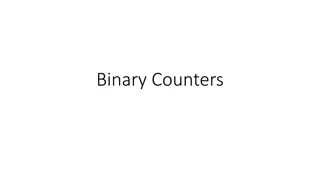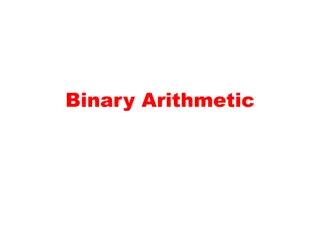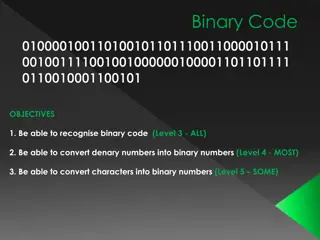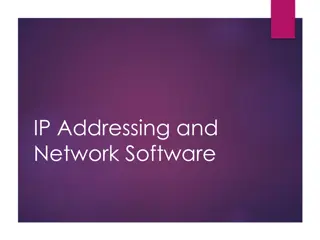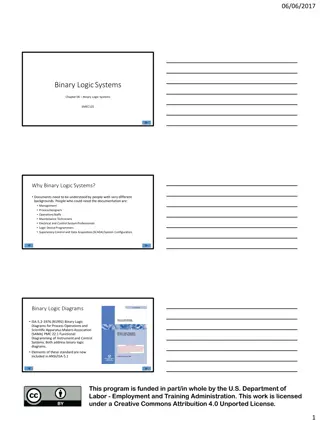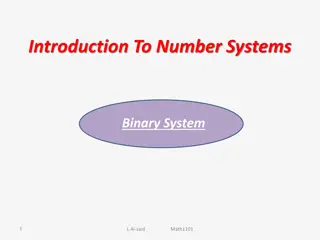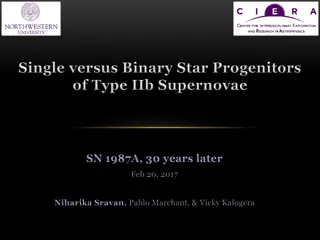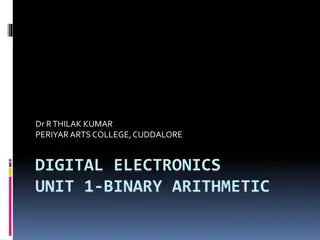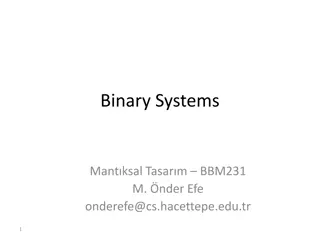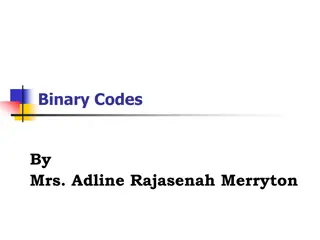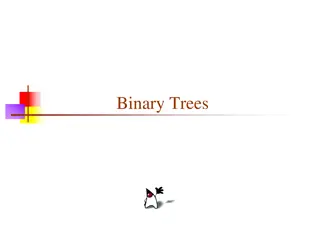Program & Application Security Through Binary Code Analysis
Risks associated with software applications on connected devices and the intricacies of analyzing closed-source software for security vulnerabilities. Delve into the challenges posed by malware attacks, code obfuscation techniques, and the importance of binary code analysis in uncovering low-level vulnerabilities.
Download Presentation

Please find below an Image/Link to download the presentation.
The content on the website is provided AS IS for your information and personal use only. It may not be sold, licensed, or shared on other websites without obtaining consent from the author.If you encounter any issues during the download, it is possible that the publisher has removed the file from their server.
You are allowed to download the files provided on this website for personal or commercial use, subject to the condition that they are used lawfully. All files are the property of their respective owners.
The content on the website is provided AS IS for your information and personal use only. It may not be sold, licensed, or shared on other websites without obtaining consent from the author.
E N D
Presentation Transcript
Program & Application Security . . . Through Binary Code Analysis Kim Redmond April 2, 2019 USC Department of Computer Science & Engineering
By 2020, there will be 20 billion connected devices worldwide. All these devices use software. We have programs and apps on smartphones, laptops, trackers, etc. We often don t know if they exploit our data or have hidden vulnerabilities. Is our data safe? What are the risks involved with these applications? How do we analyze closed- source software for security vulnerabilities?
Security Risks Android. ~40 million global malware attacks in 2016: - Infected apps - Adware - Banker malware - Sideloading - Trojans Code Obfuscation. Malware is more creative. As many previous security methods have identified malicious code signatures, or bug signatures, code is getting obfuscated so it is harder to detect. - Packing - Control flow changes - Junk code - Encryption - Polymorphism - Trigger-based behaviors iOS. Also not immune to application vulnerabilities. XcodeGhostsent device info to C&C server, which could hijack actions and perform reads/writes. Noticed by iOS developers.
Security Risks Android. ~40 million global malware attacks in 2016: - Infected apps - Adware - Banker malware - Sideloading - Trojans Code Obfuscation. Malware is more creative. As many previous security methods have identified malicious code signatures, or bug signatures, code is getting obfuscated so it is harder to detect. - Packing - Control flow changes - Junk code - Encryption - Polymorphism - Trigger-based behaviors iOS. Also not immune to application vulnerabilities. XcodeGhostsent device info to C&C server, which could hijack actions and perform reads/writes. Noticed by iOS developers. Traditional analysis techniques often require source code. But all we have are these executable programs . . . how do we examine them?
Closed-Source Software We are left with binaries after a program is compiled. Machine code binaries vary with architecture. When disassembled, they may be expressed in different assemblylanguages.
What is Binary Code Analysis? BCA analysis is a form of static code analysis that examines compiled binaries, not source code. You can reverse engineer control-flow graphs from binaries, and evaluate those paths for security and correctness. Benefits: source language does not matter; few possible assembly languages; identifies low-level vulnerabilities at the machine level Discovers: buffer overflows, injections, backdoors, rootkits
Binary Code Analysis Dynamic Code Analysis Static code analysis Symbolic execution (unscalable) Function/sequence vectors Bad if features chosen manually Compared to known signatures Instruction frequency Bad frequencies can be benign Junk code subverts this Test multiple execution paths Precise, but tedious Dynamic birthmarks
Problems with BCA Binary code analysis tends to have limitations: - - - - Packed malware is unreadable until decompressed in memory Malicious code is assumed to have function-level signatures Compiler optimizations vary Thorough models are computationally expensive Kang, et al. propose a Major Block Comparison (MBC) system that reduces overhead by identifying the core parts of binaries that probably contain malware and extracting their features.
Methodology 1. Each binary is disassembled into instructions. 2. Instruction sequences are divided into sections based on function implementations. Each section is divided into blocks. Blocks with user- defined functions, library function or API calls, or malicious instructions are major blocks. 3. Major blocks with function call instructions are selected. 4. Their similarity is calculated with malware family blocks in the database.
Block Similarity Each B is a set of opcodes; operands are file- dependent and disregarded. Each set element is a 2-gram of consecutive opcodes (i.e., MOV, JMP). NgramSet is the full set of instruction sequences from a block.
Block Similarity Similarities between two block sets are then aggregated. Each block from Set1 is compared with each block from Set2. Similarity scores are added to a table (right). The Hungarian algorithm calculates the max similarity sum based on the highest sum of edge weights (scores) for a node (block).
Results High similarity scores were computed for malware contained in the same family (e.g., trojans). And correspondingly, similarities were much lower when comparing different malware families. To reduce overhead, the results also conclude that 76% of a file s original blocks are excluded from evaluation. However this research only examines similarities for pre-computed malware examples.
Machine Learning As malware continues to evolve and dodge detection What s a method that can keep up with identifying new malware? Another Approach
Machine Learning Approaches Some attempts have been made using machine learning: Instruction2vec represents instructions as feature vectors Asm2Vec creates vectors for assembly functions Innereye-BB can convert basic blocks into vectors for multiple architectures, but each architecture must first be separately trained ...But some models exploit statistics, not semantics, of manually chosen features. Some only work on one architecture. And some are too broad!
Natural Language Processing NLP: a field of machine learning that processes and analyzes text. Efficient at extracting semantic meaning from words and documents. If we regard assembly as a language and assembly instructions as words, then we can analyze disassembled binaries as if they were documents. We can use binaries to train a model, and learn how each instruction is unique. Then we can figure out how they contribute to the program!
Word Embeddings Word embeddings are high-dimensional vectors that encode word meanings. A simple example is one-hot encoding. Given a dictionary of 100 words, each word occupies one dimension out of 100 in an all-0 vector. Consider a document about animals: Cat = [ 1 0 0 0 0 ] Bird = [ 0 0 1 0 0 ] Dog = [ 0 1 0 0 0 ] Pig = [ 0 0 0 1 0 ]
Word Embeddings Cat = [ 3 0 0 0 0 ] Bird = [ 0 0 3 0 0 ] Dog = [ 0 1 0 0 0 ] Pig = [ 0 0 0 5 0 ] If you treat each dimension as a count of how often that animal appears in the document, then the resulting vector could express them all! Document embedding = [ 3 1 3 5 ] (but what does this mean?) This also does not tell us how words are similar or different.
Word Embeddings In order to reflect what words mean, dimensions can encode statistical patterns of how words are distributed across a text. In unsupervised word embedding models, word clusters are used to learn what kinds of words tend to appear together as neighbors. Insight: if two different words tend to appear in the same contexts, then those words are probably similar in meaning.
Instruction Embeddings We can apply this logic to assembly language to generate instruction embeddings. Instructions are generally composed of opcodes and operands: ADD SP, SP, 0 When training on disassembled binary, an embedding model should learn how the opcodes are distinct and how operands tend to appear in certain orders within code blocks. Put together, the combination of instruction embeddings for a program should reflect what that program does.
What This Means for Malware If each instruction has a unique embedding, and each program a unique embedding signature, then a vulnerable program should have a distinct signature from similar, secure programs. Machine learning could detect . . . Programs with vulnerabilities vs those with none Obfuscated malware, which will have a certain execution but achieve it with different instruction patterns When vulnerabilities are distributed in sections of a program Transformation patterns for malware
BCA Tools http://bitblaze.cs.berkeley.edu/ https://github.com/BinaryAnalysisPlatform https://www.grammatech.com/products/binary-analysis https://en.wikipedia.org/wiki/List_of_tools_for_static_code_analysis
Images, Resources, and References [2]: https://pixabay.com/en/smartphone-mobile-phone-display-1717163/, https://pixabay.com/en/laptop-black- blue-screen-monitor-33521/, https://www.flickr.com/photos/121483302@N02/14019907992 [3]: https://commons.wikimedia.org/wiki/File:W65C816S_Machine_Code_Monitor.jpeg, https://commons.wikimedia.org/wiki/File:X86_Assembly_Listing_for_ComplexAdd.png Kang, Boojoong, et al. "Malware classification method via binary content comparison." Proceedings of the 2012 ACM Research in Applied Computation Symposium. ACM, 2012. https://dl-acm- org.pallas2.tcl.sc.edu/citation.cfm?id=2401672 Vectors: S. Gouws, Y. Bengio, and G. Corrado, Bilbowa: Fast bilingual distributed representations without word alignments, in International Conference on Machine Learning, 2015, pp. 748 756. 1. https://www.gartner.com/en/newsroom/press-releases/2017-02-07-gartner-says-8-billion-connected- things-will-be-in-use-in-2017-up-31-percent-from-2016 https://www.wandera.com/mobile-security/mobile-malware/malware-on-android/ https://www.preemptive.com/obfuscation https://www.synopsys.com/software-integrity/resources/knowledge-database/binary-code.html 2. 3. 4.



